For Those Who Came In Late: In recent weeks, we’ve returned to the topic of the Justice League of America; in specific, the series’ renaissance under the pen of writer Grant Morrison, who returned the team to greatness both by restoring the team’s original membership and going back to the kind of larger, epic-scale stories that the book was once known for. Let’s continue.
Dealing with a book like JLA is tricky, in that what’s happening in the solo series of the seven core members has to be addressed, or at least appear to be addressed. The small details can be glossed over, explained away as merely taking place “between storylines.” The larger stuff, such as, say, Superman suddenly having blue skin and throwing around electricity (a short-lived change tied to a storyline in his solo books), well, that’s gotta be dealt with. Such was Morrison’s task after only four issues of his new series.
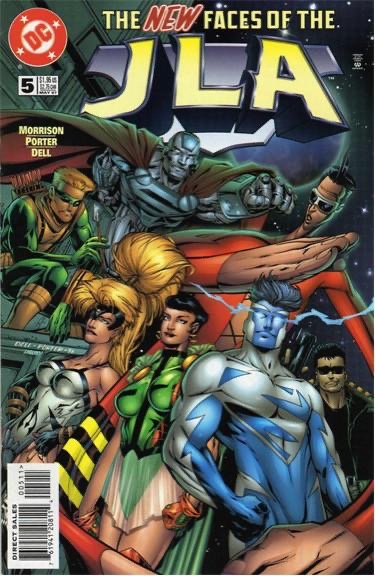
In JLA #5, “Woman of Tomorrow,” by Morrison and artist Howard Porter, Morrison introduces Superman’s new look in the context of a larger issue: new faces for the League. Here Morrison cleverly anticipated the inevitable requests from readers for new members by having the League hold a membership drive, to ward off charges of elitism from the superhuman community. In another smart move by Morrison, he foreshadows the eventual membership of Plastic Man, Aztek, Steel and Green Arrow, without rushing the new characters into the team right away, so the reader doesn’t resent Morrison’s new picks immediately altering the still-new team dynamic. And while all this is going on, he still manages to tell one of the most satisfying and bittersweet tales in his run, with the introduction of the League’s newest member, Tomorrow Woman.
The story begins with Superman as the lone attendee at the funeral of Metamorpho, following his sacrifice in saving the former Leaguers in the first issue. Only a bit of lip service is given to explaining the electric Superman’s new status quo, in a terse exchange between Superman and Batman:
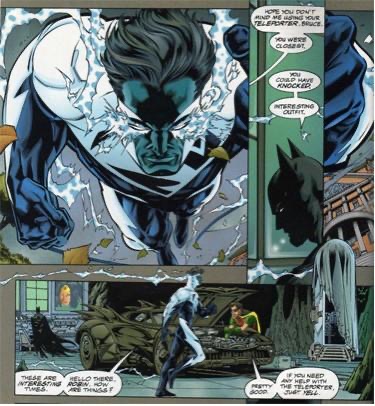
Anyway, the League’s new-member interviews wind up being mostly unremarkable, until the arrival of Tomorrow Woman, a prospective member who impresses the team with her strength, power and spirit, and is immediately made a member.
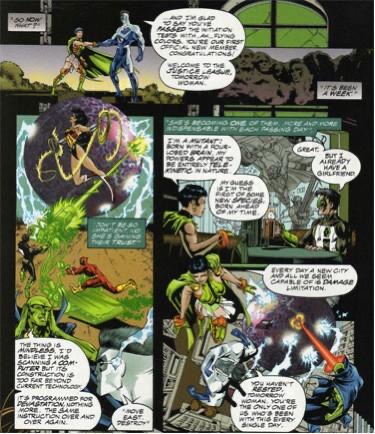
Little do the JLA suspect that Tomorrow Woman is really an android, the creation of the League’s longtime enemies Professor Ivo and T. O. Morrow, in their latest attempt to destroy the League.

As Tomorrow Woman continues to gain the team’s trust, Ivo and Morrow are ready to execute their masterstroke, triggering an electro-magnetic pulse weapon in Tomorrow Woman’s android heart that will snuff out all electrical activity in the brains of the JLA. When the time comes for Tomorrow Woman to pull the trigger, however, things don’t quite turn out as planned:

Morrow had done his work too well in creating her brain, which had spontaneously generated a code of ethics, and instead sacrificed her own life to save those of her new teammates. Soon enough, the JLA is at Ivo and Morrow’s doorstep…

…while Superman finds himself back at the cemetery.

A wonderful single-issue story from Morrison and Porter.
Morrison fakes out the readers again in JLA #6-7, with what looks like another prospective new member in the introduction of Zauriel, a Guardian Angel who flees to Earth after falling in love with one of the mortals under his watch, and is pursued by Asmodel, one of the Heavenly Host who’s determined to return Zauriel to Heaven (ostensibly for his betrayal, but in actuality because Zauriel has learned of his plans to overthrow the Almighty).
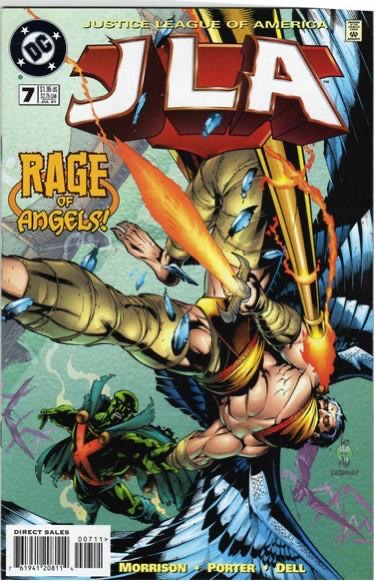
Zauriel is one of Morrison’s better creations, a completely earnest and matter-of-fact chap who just happens to be an angel. Zauriel’s first meeting with Aquaman is met with a bit of confusion (particularly as the issue of Hawkman’s existence at the time was an utter continuity mishmash):

Zauriel takes a moment to explain to the Justice League just how serious the situation is, in classic Morrison-penned hyperbole:
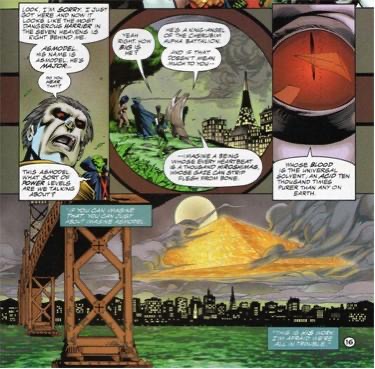
The League and Zauriel put their heads together for a way to send Asmodel back to heaven, with Flash and Green Lantern utilizing supersonics to disrupt the seraphim’s connection with the mortal plane, while Superman provides this issue’s epic moment, taking his place as the Biblical Jacob, wrestling an angel.

The League extends an offer of membership to Zauriel, but he declines, heading off into his own 4-issue miniseries. This story leads right into the next, which finally does add a new member to the League, as the JLA, preparing for Green Arrow Connor Hawke’s induction, is waylaid by another old JLA enemy, the Key, who places the Leaguers in a dreamstate and plans to use the psychokinetic energies of their brains to open a doorway into an all-new, uncharted negative dimension.
In “Imaginary Stories,” by Grant Morrison and Oscar Jimenez, published in JLA #8 and #9, Connor Hawke is returning to the JLA Watchtower on the moon for what seems to be a second interview for membership, only to find the JLA captive and unconscious at the hands of the Key, a old-school JLA villain who has increased his abilities considerably, and is subjecting the Leaguers to vivid hallucinations in order to harness their brain power, to allow him to open a doorway to a newly discovered dimension known as “negative space,” which he believes will grant him unlimited power.

While the Justice League struggles through naggingly familiar dreamlives (including a scenario in which an elderly Bruce Wayne and his wife Selina Kyle have to protect new Batman Tim Drake and their son, the new Robin, from a terminally ill and crazy-as-ever Joker), Connor is alone, fighting for his life against the Key and his troop of robot bodyguards. Even worse, early on in the battle Connor is grazed by a blast from the Key’s energy rifle, destroying his quiver and all his arrows, leaving him weaponless.
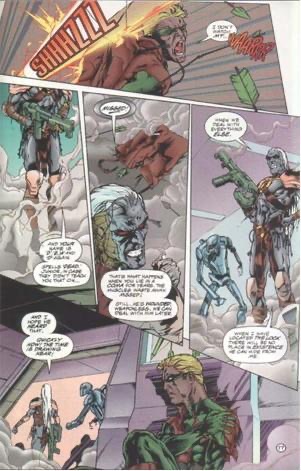
Desperate, Connor makes his way to the Justice League’s Trophy Room and smashes open the case containing Oliver Queen’s famous array of trick arrows, the prospect of which don’t exactly fill Connor with confidence:
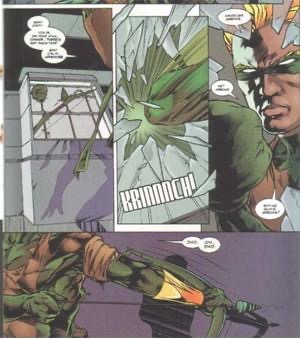
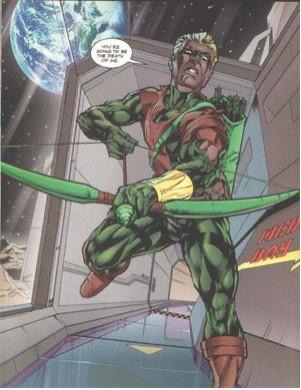
Connor struggles with his father’s ridiculous gimmicked arrows against the Key’s robot soldiers, succeeding as much through instinct as ability.

Overwhelmed by feelings of inadequacy, Connor bails out on the final confrontation with the Key, leaving the Flash to face him alone, or so it seems.
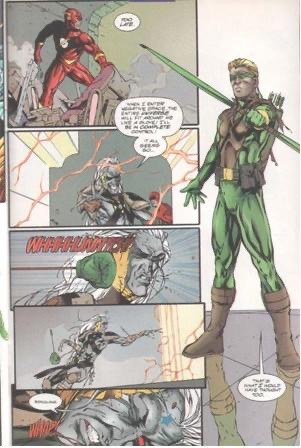
With that, Connor’s place in the League is assured.

The stage was now set for the next and most dangerous threat for the new League to face, which would take place in Morrison and Porter’s biggest and most ambitious storyline yet, “Rock of Ages.” But first, to set the stage, would appear JLA SECRET FILES & ORIGINS #1, in which we see the formal incorporation of the team in an encounter with Starro the Conqueror that took place between the events of MIDSUMMER’S NIGHTMARE and JLA #1. A nice little story by Morrison and Porter, but nothing terribly consequential, notable mostly for an appearance by the Spectre.
“Rock of Ages,” a six-part epic taking place in JLA #10-15, is far too circuitous and wild to cover point by point here, with enough subplots and cliffhangers to fill up a year’s worth of any other series. And besides, you really should go pick up the trade and discover it for yourself. But I’ll walk you through a few of the high points. As the story begins, the League (including new members Connor Hawke and Aztek, who had just joined in the final issue of his solo series, and minus Wonder Woman, who had just “died” in her solo series. Not to worry though — to paraphrase MONTY PYTHON’s John Cleese, she got better) finds itself facing off with evil hard-light duplicates of themselves who are terrorizing Star City.
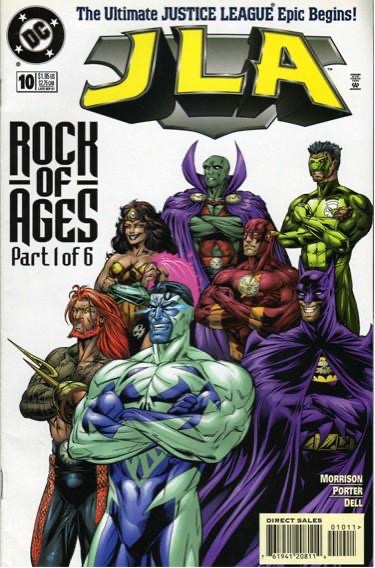
Who’s behind it? Lex Luthor’s new Injustice Gang, consisting of the arch-enemies of all the Leaguers: Luthor, the Joker, Circe, Dr. Light, Ocean Master, Mirror Master and in a nice surprise as J’onn J’onzz’s opposite number, J’emm, Son of Saturn, an obscure ’80s DC character being used as a telepathic tool by Luthor.
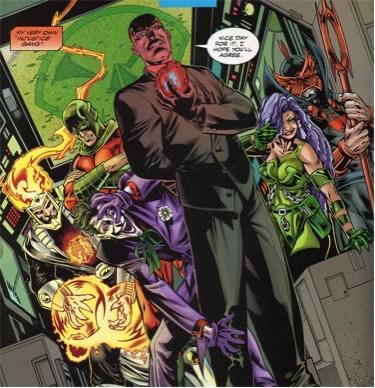
Luthor, we soon learn, is approaching the destruction of the Justice League like any other corporate takeover: “We identify their weak points, destabilize their figureheads, headhunt the up-and-coming hotshots…” Why now, for Luthor? Why get directly involved with the Justice League in so aggressive a fashion? He enlightens us:

Unfortunately for Luthor, his corporate takeover of the Justice League didn’t take into account one factor: Batman.

Luthor also has an immensely powerful trick up his sleeve: the Philosopher’s Stone, a relic he’s acquired that allows him to reshape reality to his very whim.
In classic Justice League fashion, the team splits up to face the threat, with Superman and J’onn lured into an orbital trap, while Connor Hawke and Green Lantern find themselves being recruited by Circe, at the same time that Batman is doing his own recruiting, outbidding Luthor for Mirror Master’s services and bringing in Plastic Man for a special infiltration mission.
Meanwhile, Green Lantern, Flash and Aquaman are tricked by a time-traveling Metron of the New Gods, who convinces them to go along on a cosmic wild goose chase after the same Philosopher’s Stone that Luthor has, and the trio winds up 15 years in the future, on an Earth enslaved by Darkseid, all because the Justice League destroyed the Stone in their battle with Luthor.
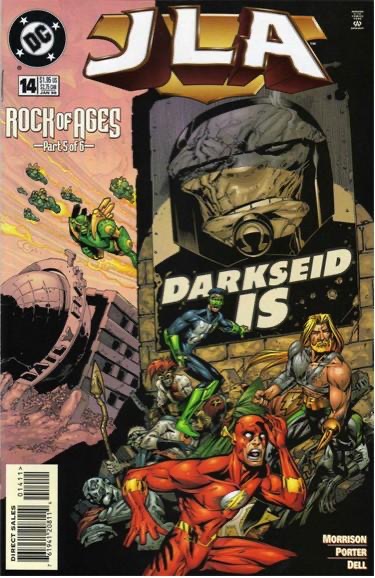
And at the same time, the League’s newest recruit Aztek, left at the Watchtower, is faced with his own Hobson’s Choice, as Luthor radios in with a revelation, that he had been the major financier for the Q Foundation that raised and trained him, not because he believed in their story about the forthcoming attack of the Shadow God, but so that he could have his own personal superhero in the Justice League.
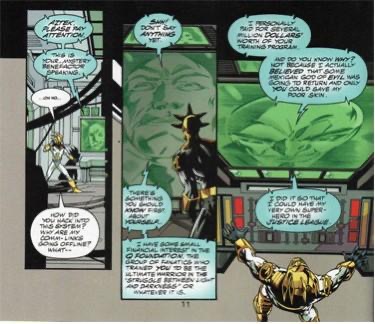
Aztek’s choice? Either work for him, or blow up with the rest of the Watchtower, as a result of the 12 nuclear missiles that Luthor unexpectedly teleported smack in the middle of the JLA’s headquarters.
To go back to the ugly Darkseid-conquered future for a moment, it’s pretty grim stuff, with only Wonder Woman, the Atom and Connor Hawke still fighting the good fight, along with a reprogrammed Amazo, Aztek’s female successor and the short-timer Teen Titan Argent.

And naturally, Batman, who’s survived years of torture at the hands of Desaad, and now has a plan to take out Darkseid. The final gambit to take down Darkseid, executed by, of all people, Connor and the Atom, is sheer brilliance.
So how does it all turn out? Sorry, but I’m not giving it up that easily. “Rock of Ages” is just too much of a pure Morrison roller-coaster ride to deprive anyone of experiencing it for themselves. It’s maybe Morrison’s best achievement on the series (with the possible exception of DC ONE MILLION, which we’ll touch on next week, and cover in full in a later column), perfecting his full-tilt top-speed storytelling approach and combining it with strong, innovative new concepts, a careful eye for the characters’ histories and keen, compelling characterization. Trust me – go pick up the trade. However, by story’s end both Connor Hawke and Aztek have decided to quit the team, and Superman has his own unexpected announcement: after consulting with Batman and Aquaman, the decision has been made to disband the Justice League.
Now what? Meet up back here next week to find out.

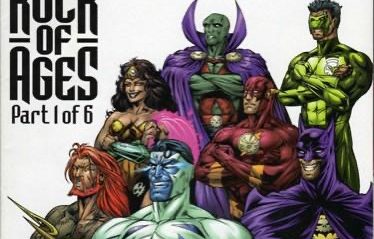
Comments are closed.